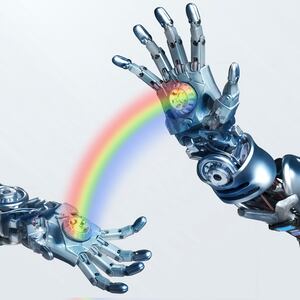There’s a bit of an obsession in robotics to create machines that can mimic the physiology and behavior of living things. And that includes giving them bodies that have parts that function like living tissues and organs.
Well, eat your non-existent heart out, Tin Man. Researchers from Cornell University and the U.S. Army Research Laboratory just developed an elastic, deformable pump that functions like an animal’s heart—essentially allowing some robots to putter around with a circulatory system. The new breakthrough is reported in a new paper published this week in PNAS.
“We’ve had robot blood that we published from our group, and now we have robot hearts,” Rob Shepherd, a Cornell engineer who helped lead the new research, said in a press release. “The combination of the two will make more lifelike machines.”
ADVERTISEMENT
You’re probably asking why on earth would we want to give machines a circulatory system, considering that it’s often a liability for human beings and other living things on the planet. But not all robots are made of metal and wire. Scientists are interested in developing “soft” robots that are made of squishy materials, allowing them to move around and navigate in strange and extreme environments with flexibility and adaptability; or assist in more practical applications like the medical care and rehabilitation of patients.
A circulatory system can help soft robots store energy and power their limbs to move around and actually execute specific, complex tasks.
The new pump is elastic and flexible thanks to its silicone composition. It consists of coils of wire—solenoids—that provide some structure while still allowing the pump to bend and stretch.

A diagram of the deformable heart, consisting of a silicone tube with coils of wire spaced around its exterior. Inside the tube is a solid core magnet that moves back and forth, much like a floating piston, to push fluids forward with continuous force.
Courtesy Cornell UniversityA magnetic core inside the pump’s tube is submerged in a specialized fluid that stiffens when exposed to a magnetic field, keeping the core centered and sealed. Changes in the magnetic field help move the core to push fluids around—creating the function of a pumping heart.
Emulating the biology of animals is harder than it looks, though. While the researchers say the pump can operate at pressures 100 times better than what previous experiments have found, it's still 10 times lower in performance than higher-end pumps that might confer more practical capabilities for a soft robot.
Still, the deformability of the pump means it could be tailored for many different kinds of robots. We’re not so distant from a future where blood and guts become a normal part of a robot’s insides.






